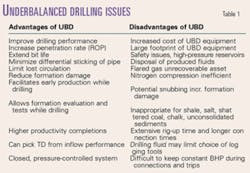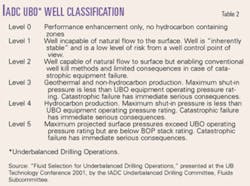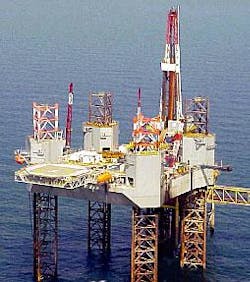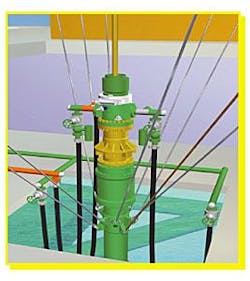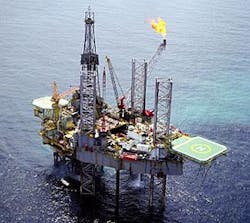Drilling underbalanced, or near balancedwith lightweight drilling fluids, has practical applications offshore.
Underbalanced drilling (UBD), a technique in which the hydrostatic head of drilling fluid is intentionally designed to be lower than the formation pressure, has been successfully used for more than a decade onshore. It is useful for infill drilling in depleted fields and in developing lower-permeability reservoirs.
According to Kip Pratt, drilling engineering advisor at Shell Canada Ltd., Calgary, more than 15,000 underbalanced wells have been drilled on land in the US and Canada as of September 2002, of which only 9,000 were drilled underbalanced over the entire planned length and into completion.1
UBD can solve some drilling problems in certain circumstances, such as low penetration rates, differential sticking, and lost circulation (Table 1).
It is most often used to prevent formation damage. Lightweight drilling fluids are less likely to invade formations, and there is no filter cake or mud cake buildup to impede flow from the reservoir.
The offshore environment presents special drilling challenges. There is a narrow window between the formation pore pressure and fracture gradient (PPFG). This dictates conservative casing programs during conventional drilling.
Operators are also wary of shallow water flow hazards. Rig space is limited; all equipment must be compact. Drilling gases and other drilling fluid components must be generated or stored on the rig.
Underbalanced and near-balanced drilling has been used offshore only in the southern North Sea, in the South China Sea, and off Brazil. Some of the reasons for limited use of the technology offshore are the high cost, safety issues, high-pressure reservoirs, regulatory restrictions, and the large footprint of the required equipment.
Maurer Technology, in a 2002 technical proposal to the US Department of Energy, stated that "UBD procedures have been used in about 100 marine locations by most major operators."2 These were drilled from fixed platforms.2
In all drilling situations, the operator wants to maintain a stable wellbore. It's equally important to drill safely in the most cost-effective manner, maximizing potential reservoir deliverability and resource recovery. Unstable wellbores can suffer near-wellbore collapse (washouts, tight holes) or formation invasion (lost circulation, wellbore breathing, or ballooning into fractures).
Ron Hyden, global business development and marketing manager for Halliburton's underbalanced applications (UBA) group told OGJ, "Most [UBA] jobs are targeting enhanced production while solving a drilling problem. There seems to be an adoption cycle in the industry. First, operators want service companies to do the work safely. Second, they want to solve a drilling problem. Third, they want to enhance reservoir performance."
Downhole data
It's critical to continually monitor bottom hole pressures (BHP) during underbalanced drilling. There must be pressure while drilling (PWD) sensors downhole and continual monitoring of PWD data to detect increasing annular pressures.
It is also useful to have at least basic well log data (gamma ray, resistivity) from LWD tools. Log data aid formation evaluation and may signal movement into a formation unsuitable for UBD.
Drilling fluids
There are four categories of drilling fluids available:
1. Gaseous drilling fluids, generally nitrogen or air.
2. Two-phase drilling fluids, such as foams, mist, or gasified liquids.
3. Artificial lift systems, such as annular or concentric gas lift.
4. Light fluids, ranging from water to oil.
Nitrogen is most often used because it provides scale control and is not flammable. Although nitrogen generation is inexpensive, it is awkward to produce offshore.
Air injection contributes to pipe corrosion, and air should not be used when drilling for gas because of safety concerns; It increases the chance of downhole fires.
Foams are more stable than aerated fluids, easy to generate and control but more costly, and disposal is difficult offshore. Foams are also limited by temperature and thus cannot be used at great depth.
The selection of a drilling fluid partly depends on the IADC UBO (underbalanced drilling operations) well classification. This characterizes wells from low-risk Level 0 to high-risk Level 5 (Table 2). In UBD, negative differential pressure between the formation and the drilling fluid stimulates the flow of formation fluids into the wellbore.
Various injection techniques are used in UBD.
Drillstring injection is the most common and requires no additional downhole equipment. But it restricts the use of MWD pulse tools.
Annulus injection using a parasite string (a second pipe run outside of intermediate casing) allows injection during trips, but it can't be retrofitted to older wellbores and is only used in vertical wells.
Annulus injection using a concentric string also allows injection during trips, but the injection point is fixed by casing depth. Conventional gas lift is also possible.
Any type of injection requires careful attention to downhole pressure management (OGJ, June 16, 1997, p. 54).
The lower limit for safe drilling fluid (mud) weight is the greater of formation pore pressure or minimum mud weight necessary to prevent borehole collapse. The upper limit for safe mud weight is that which would initiate fracturing and result in drilling fluid losses into the formation. There is a balance between maintaining sufficient density to move cuttings and keep the hole clean and avoid fracturing the formation.
Equipment
Specialized surface equipment is necessary for UBD to manage downhole pressure and well control (primary and secondary flow lines, working blind ram), four-phase closed-system separation (oil, gas, water, cuttings), gas injection, rig-assist snubbing, monitoring (pressure, temperature, flow rates), facilities to analyze fluids, cuttings and gases, and to monitor downhole data (PWD, LWD, MWD). Membrane nitrogen generation systems are often installed and produce about 95% pure nitrogen.
In order to drill underbalanced safely in the marine environment, there are different types of rotating control heads for rigs with either surface or subsea blowout preventers (BOPs). Returns at the surface need to be controlled by a choke manifold system independent of the rig manifold. Drillers need tools to control and manage equivalent circulating density (ECD) to prevent downtime.
Floating vessels with risers require additional considerations that are not factors in land drilling. The riser is the weakest mechanical component in the BOP stack, and the riser stress must be continually monitored.
There are various commercial software packages available to model different aspects of underbalanced drilling. This includes Houston-based Mauer Technology's Mudlite simulation program for offshore drilling operations.
Houston's Signa Engineering Corp. offers its Hydraulic Underbalanced Simulator software (HUBS), a state-of-the-art hydraulics simulator for modeling underbalanced operations.
Hyprotech and Baker Jardine Petroleum Engineering & Software are jointly marketing their PIPESIM Suite and Hysys multiphase flow simulator and network analysis.
Historical adaptation for offshore
Shell UK Exploration & Production (Shell Expro) and Smedvig Offshore ASA initiated a joint project in 1995 to apply UBD techniques offshore. The work was successfully tested in the UK sector of the southern North Sea, where Shell's Leman A27 gas well reached TD on July 4, 1997.
Smedvig was appointed Shell's lead contractor for UBD in the southern North Sea and Shell Brent field and drilled several more wells through 2002 using the Santa Fe International jack up Britannia (Fig. 1). This is a type D-221 jack up, with approximately twice the deck space as an MLT 116C jack up. The extra deck space was necessary because of the 140 tons of added UBD equipment.
Cenpes, the R&D division of Petroleo Brasileiro SA (Petrobras), began working in 1997 to investigate the possibilities of using UBD offshore. In 1998, the company formed a joint industry project to investigate "offshore floating drilling with lightweight fluids."3
null
Petrobras and the Rio de Janeiro-based COPPETEC Foundation (Fundação Coordenação de Projetos, Pesquisas e Estudos Tecnológicos) led the JIP with participation from Amerada Hess Corp., ExxonMobil Corp., Royal Dutch/Shell Group, Weatherford International Inc., Sweden's Alfa Laval AB, and London-based Impact Engineering Solutions.
The Petrobras XVII semisubmersible performed the field test in 300-m water depths in the Campos basin, off Macae, Brazil, drilling the Albacora 64H development well in December 2000. Most of the hole was drilled conventionally, and only the final 38 m was drilled near-balanced with gasified mud (nitrogen injection).
As such, it tested facets of the underbalanced drilling concept: nitrogen injection while drilling, ability to cap the drilling riser, surface system capacity to handle three-phase separation, and the system capacity to handle nitrified drilling fluid.
A critical element was Petrobras' use of a rotating control head mounted on the surface BOP, which enabled a closed and pressurizable annulus returns system (Figs. 2 and 3). Don Hannegan, functional director of UBS at Weatherford, said wells drilled with the use of a rotating control head have established a much better well control track record than those drilled without benefit of the tool.
Marine UBD
Several wells in a six-well program, spaced over several hundred square miles in the Carnarvon basin, off northwest Australia were inadvertently drilled underbalanced (OGJ, Dec. 17, 2001, p. 37).
Author Phil Holbrook reported that "drillers were unable to detect a 3-ppg underbalanced condition, from 2,850 to 3,225 m, at the surface. Drilling mud gas did not provide adequate warning." In general, regional pore-pressure predictions matched RFT pressures. The operator benefited from force-balance pore-pressure calculations made in the field, using the information to circulate out gas-cut mud instead of shutting in the well, and was able to reach TD with one less casing string.
Shell Malaysia E&P used UBD to drill two wells in a shallow clastic oil field offshore Sabah, in the South China Sea. Shell operates the St. Joseph (SJ) field in a joint venture with Petronas Carigali. Underbalanced drilling was used in order to prevent formation damage to the pressure-depleted sandstone reservoir. The drilling fluid was native crude oil injected with platform lift gas. Shell used the Pride Hawaii, a medium sized, independent leg cantilever jack up rig with limited deck space (Fig. 4).
Using drillstring gas injection prevented Shell from using a downhole MWD pulser, as gas in the drilling fluid over-attenuates the pulser signal. The alternative is to use electromagnectic (EM) MWD to receive directional, gamma ray, and pressure data.
The operator found that the "open-hole was remarkably stable during the entire operation," and they were able to achieve the desired "zero-skin" state in the clastic reservoir but determined that UBD technology was "embryonic" and in "direct competition with more established and much easier/cheaper strategy of Under-Balanced Perforating (UBP)."4
Statoil ASA announced plans in May 2003 to use underbalanced drilling at Gullfaks C; this will be the first UBD on the Norwegian shelf. Gullfaks C is a concrete, gravity-base structure with four shafts in 217 m water; the deck is 142 m long and 40 m wide.
In a September 2003 press release, Johan Eck-Olsen, Statoil's drilling project manager said, "Drilling underbalanced is an important method for solving complex drilling problems and will help increase the oil recovery from fields that are already in production."
Prosafe Drilling Services was awarded a contract to drill five underbalanced wells for Statoil over 2 years.
Halliburton Energy Services in Norway is also contracted to provide UBA engineering and support for the Gullfaks field. The project is set to begin first-quarter 2004, according to Ron Hyden.
null
Statoil is trying other cutting edge technologies to overcome problems of a high-pressure zone in the Gullfaks field. In October, the company announced success installing Enventure Global Technology's large-diameter solid expandable tubular system (open hole liners) in the Gullfaks C-43 T2 well at a 77° angle.
A new type of platform for UBD was jointly developed by the Swiss consultancy Eboroil SA and the Norwegian petroleum engineering company IPEX AS.5 Eboroil, IPEX, and Weatherford incorporated Multi Operational Service Tankers Inc. (MOST) inJanuary 2002. The MOST concept is based on use of a 150,000-ton, dynamically positioned tanker as a drilling platform.
The company believes the length of the ship will result in lower heave than experienced by semisubmersibles. Drilling and intervention services will employ coiled tubing instead of joined pipe. The plans include a four-phase separation facility onboard and oil storage tanks with a total storage capacity of 600,000 bbl.
Concerns
Underbalanced drilling can add 40-100% to the AFE (authorization for expenditure), with an average cost of $200,000/day offshore. Chitty devised a general AFE equation for UBD costs.6
AFE = Crig + CUB + Cfuel + CFG + CKEC
The costs include the drilling rig (Crig), underbalanced services (CUB), fuel (Cfuel), flared gas (CFG), and Kyoto Emissions Credits (CKEC). Chitty states "Underbalanced drilling is a tangibly expensive process that is inefficient on a macro level. Many of these inefficiencies are pervasive because equipment used for UB is antiquated."
He specifically cites "expensive, bulky, fuel-consuming compression equipment" used to generate nitrogen for injection and "archaic" separation systems that flare both nitrogen and produced hydrocarbons, and concludes "traditional underbalanced drilling is expensive and difficult to justify in an offshore operation."6
null
Related techniques
Dual-gradient drilling technology, also known as dual density, was tested for the first time in November 2001 on Diamond Offshore Drilling Inc.'s Ocean New Era semisubmersible (OGJ, Jan. 7, 2002, p. 78). Conoco Inc. was the administrator for the Subsea Mudlift Drilling joint-industry project, and Hydril Co. was the project designer. The No. 8 well was drilled in the Shasta field in 910 ft water, on Green Canyon Block 136, operated by Texaco Inc.
Dual-gradient techniques are being considered for ultradeepwater wells where the PPFG is particularly narrow and the need to reduce riser stress becomes critical. In this situation, two fluid gradients are maintained in the wellbore using seafloor pumps: seawater in the annulus from the rig floor to the mudline, and a mud column from the mudline to TD. Mud returns to the surface via an auxiliary line, separate from the conventional riser.
Another method of maintaining a dual density column, without a seafloor pump, is to use mud pumps to inject hollow glass spheres into the bottom of the riser to reduce the mud density in the riser to that of seawater. Theoretically, the large lightweight particles could be easily screened out of the drilling mud.
Mudcap drilling or pressured mudcap drilling uses some of the same equipment as UBD and can be used to ameliorate lost circulation.7 Signa Engineering worked on a mud cap drilling engineering design project for Shell Venezuela.
This involved a highly fractured sour abnormal (14 PPG emw BHP) oil reservoir in Lake Maracaibo.
The project called for a diesel-based drilling fluid injected with membrane-generated nitrogen, and four-phase separation technology.
UBD equipment and techniques can also be used to optimize slim riser deepwater drilling with a surface BOP stack, i.e., to enable low head drilling (LHD) or the operator can use the closed system created with UBD equipment to permit better ECD control, and to reap the environmental and safety benefits.
Don Hannegan, Weatherford, told OGJ "many see managed pressure drilling as a step change towards underbalanced drilling in marine environments."
Managed pressure drilling is a variation that also utilizes part of the UBD "kit."
The intention is to use a closed system to closely monitor and stay within the wellbore pore pressure and fracture gradient margins, which includes near-balanced drilling.
Helio Santos, vice-president, technology, Impact Engineering Solutions, London, told OGJ, "What the industry is really moving towards is what we are calling Managed Pressure Drilling – MPD. MPD uses the majority of the equipment from UBD, but the intent is not to be truly underbalanced, producing hydrocarbons. We can close the well and control the pressure inside the wellbore, without having to separate, store, and transport huge volumes of oil and gas."
ConocoPhillips is hosting a managed pressure drilling forum, Jan. 27-29, 2004, in Galveston, Tex.
It will feature case studies and reports on state-of-the-art equipment and techniques.
Future improvements
As always, pushing the technology envelope requires more-efficient, streamlined equipment. In order for underbalanced drilling technology to succeed, it will have to become less expensive and more cost-effective.
Among the critical components needed for offshore UBD or MPD systems are better, (more efficient), nitrogen generation facilities, streamlined, modular, multiphase separators with small footprints; reliable data acquisition systems; and development of foams that can withstand higher temperatures and thus used at greater depth.
Antonio Lage, Petrobras-Cenpes, told OGJ.that recent technological developments such as surface BOP's and telemetry alternatives (smart drillpipes), will favor the implementation of UBD in deep water in the future.
null
Computer flow modeling tools will undoubtedly be increasingly refined. Perhaps UBD or managed pressure systems will be integrated into drilling platforms.
Will we see unadulterated underbalanced drilling used in the ultradeepwater? Santos thinks not but takes it a step beyond and proposes the "microflux control" approach to drilling the ultradeep.7 It combines the best features of UBD, conventional drilling, and near-balanced drilling (NBD) to safely drill as close as possible to the pore pressure curve and avoid risky kick and loss situations (OGJ, May 12, 2003, p.22).
Arthur C. Clarke said, "The only way of discovering the limits of the possible is to venture a little way past them into the impossible."
References
1. Pratt, C.A., "Underbalanced Drilling: The Past, The Present, and the Future," paper presented at SPE/AFTP section meeting, Paris, Sept. 16, 2002.
2. "Determine the Safe Application of Underbalanced Drilling Techniques in Marine Environments," technical proposal to DOE from Maurer Technology Inc., June 17, 2002.
3. "Petrobras Joint Industry Project: Offshore Floating Drilling with Lightweight Fluids," Impact Engineering Solutions.
4. Bourgeois, G.D., "Under-Balanced Drilling Experience in a Shallow Clastic Oil Field, Offshore Sabah, South China Sea," paper presented at SPE's Asia Pacific Oil & Gas Conference in Jakarta, April 2003.
5. Multi Operational Service Tankers Inc., http://www.most.no/General_Introduction.html, Oct. 9, 2003.
6. Chitty, G.H., "Is a Zero AFE Possible with Underbalanced Drilling?," presented at the Offshore Technology Conference, Houston, May 5-8, 2003.
7. Santos, H., et al., "Micro-Flux Control: The Next Generation in Drilling Process for Ultra-deepwater," presented at the Offshore Technology Conference, Houston, May 5-8, 2003.
